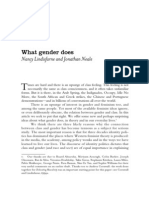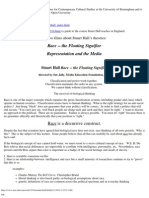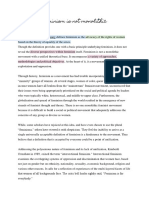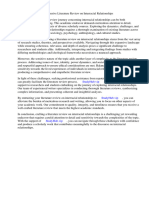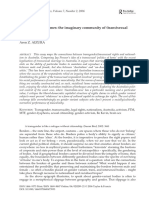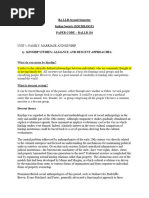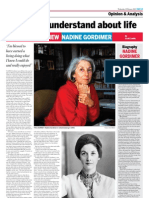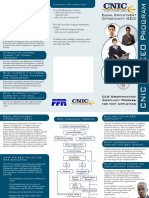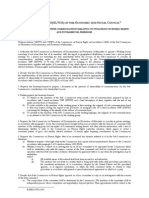Gwsmidterm PDF
Gwsmidterm PDF
Uploaded by
pluto nashCopyright:
Available Formats
Gwsmidterm PDF
Gwsmidterm PDF
Uploaded by
pluto nashOriginal Title
Copyright
Available Formats
Share this document
Did you find this document useful?
Is this content inappropriate?
Copyright:
Available Formats
Gwsmidterm PDF
Gwsmidterm PDF
Uploaded by
pluto nashCopyright:
Available Formats
GWS50AC Midterm
Chatterjee 1
Upasana Chatterjee
Dr. Barbara Barnes (Reader. Erin Bennett)
GENDER IN AMERICAN CULTURES
20 October 2015
Midterm Exam
1. WHAT IS GENDER? WHAT IS A NATION? AND WHY IS GENDER RELEVANT TO STUDIES OF
NATIONS/NATIONALISMS?
For a large part of written history, gender had been defined through biology, in the
sense that male or female genitalia at birth determined whether one was a man or a woman.
Towards the latter 1960s, the definition was brought into question (Pascoe 272), and now is
taken to be a social construct that is produced by culture (e.g. systems of family and kinship),
not nature, and is thus dependent on time and place. In this way, gender became to be understood as the attitudes, behaviours and social structures while sex became purely biological
(Pascoe 273). The two need not bear any relation as attitudes or behaviours need not bear
any necessary relation to biology (Pascoe 273).
Benedict Anderson suggests that a nation is a imagined political communityand
imagined as both inherently limited and sovereign (6). Extending on the definition, Anne
McClintock adds that nations are historical and institutional practices through which social
difference is invented and performed (61). Through these two working definitions on a topic, Ive come to understand that a nation is in many ways like a family. Just like we can never
know everyone in our nation, we can never know our complete family, yet we usually share
an instant intimacy even with those (family) members we only meet once in our lives, as we
believe that our shared history brings us together and unites our identities in some way. Similarly, in both there are always social hierarchies. Some are better liked, while others may
even be cast out. Both groups also create loyalties by using in-group favouritism and outgroup derogations. As there are remarkable similarities in how we interact with, and are
GWS50AC Midterm
Chatterjee 2
shaped by, both our family and our nation, a nation is, while being an imagined community
constantly changing through historical and cultural practices, also a representation of the extended family model on a much larger scale.
If we continue to use the idea of a large extended family as a condensation of the nation, we can see why gender becomes critical to building a nation. When we are born into our
family, the first thing we know are our parents, or our predecessors if you will. The way we
understand them is in their differences and in the way they work together. The first thing most
people notice about their parents is that they are usually a man and a woman, and that families consisting of one mother and one father are the norm.1. Furthermore, in the traditional
hetero-patriarchal model, each parent also has strict roles thrust upon them. The father is traditionally the breadwinner, while the mother is seen as the nurturing figure. In this way, the
father represents the family in the larger world, and the mother looks after the wellbeing of
the family.
These gender roles in the family are projected onto the types of roles men and women
play in a nation. Tom Nairn suggests that the nation is the modern Janus (qtd. in McClintock 65) in that it looks back in time while also looking forward to the future. McClintock
suggests that this contradictory nature is reconciled by a natural division of gender (66).
She proposes that men represent the progressive agent of national modernity while women
are represented as the atavistic and authentic body of national tradition (66). These rolls
hold certain parallels to gender rolls in parenthood. Both represent men as active agents and
as interacting with the world, while women are given more passive and traditional roles that
do not require innovating.
1
Today, although there is more acceptance for families that deviate from the model tradition-
al, one mother and one father model, they are still just that: deviations. In popular media, and
in real life, the traditional model of the hetero-patriarchal family is still the norm.
GWS50AC Midterm
Chatterjee 3
Thus, as gender in family is assigned different values and roles, and as family is a
model for nations, gender has an important role in defining a nation, and in its citizens creating a community they can identify with. Given the symbolisms and values that Anne McClintock suggests are given to the different genders, it is important again to consider how gender
is defined. As long as the hetero-patriarchal model is the norm, gender becomes intrinsically
tied to biological sex, as only females can be mothers, and only people who have uteruses
and have had, currently have, or someday will have the potential to bear children can ever be
females in the hetero-patriarchal model.
GWS50AC Midterm
Chatterjee 4
2. WHAT IS INTERSECTIONALITY? AND WHY IS THIS CONCEPT RELEVANT WHEN INQUIRING
INTO THE TERMS OF NATIONAL BELONGING? IN OTHER WORDS, WHAT DOES THE TERM
INTERSECTIONALITY MAKE VISIBLE/WHAT KINDS OF INQUIRY ABOUT NATIONAL BELONG ING DOES IT ENABLE
Kimberle Crenshaw introduced the term intersectionality, when she points out that in
society, and often, under the law, if one follows the intersection of different marginalised
groups, then those who fall in that intersection are often invisible (392). She illustrates this
example by citing the case of DeGraffenreid v. General Motors, where five black women
brought suit against General Motors, alleging that the employers seniority system perpetuated the effects of past discrimination against Black Women (Crenshaw 384). The court reasoned that there was no racial or sex discrimination. It just so happened that the only black
people employed were men and the only women employed were white. The stories of white
feminists are seen to apply to all women, while the men of colour are seen to represent all
people of colour. As a result, black women, who fell in the intersection were invisible in the
eyes of the law.
Lisa Duggan studies another example of intersectionality in the case of Brandon
Teena. Here Teena was at the intersection of a non-binary gender identity and poverty, as his
biological sex did not match with his gender identity and both the expression of gender (214)
and ones biological sex can lead to different systems of oppression2. Furthermore, this story
is complicated by the mass deindustrialization of the time, which suggests that socioeconomic status could be one of the intersections too, as all the victims and perpetrators were not
For example, a biological man, who identifies as a male is treated differently from a biolog-
ical man who associates with a female gender identity. For that matter, there is oppression
given biological sex from birth itself, before a gender identity can manifest. Babies are gendered through colours (e.g. blue for boys, pink for girls) and descriptors (handsome, strong,
beautiful, sweet).
GWS50AC Midterm
Chatterjee 5
with stable jobs and faced changes in social status. In this chapter, Duggan describes intersectionality as crossing lines (219), which I believe is a clever complement to Crenshaws proposed definition.
From these course readings, I have understood intersectionality as the existence of
multiple systems of oppression on people who are members of more than one oppressed
group. Through intersectionality, one is able to get a more complete picture of how discrimination and privilege works at these intersections3.
In our proposed definition of a nation earlier, I referred to Anne McClintock who suggested that nations are built on principles of exclusion and social difference. As intersectionality aims to study systems of exclusion and the existence of multiple systems of oppression,
we can see that understanding intersectionality may give us a better understanding into how
belonging in a nation is created.
Consider the case that Ronald Takaki presents in Race & the end of History. He
discusses the particular plight of Asian Americans, who are seen as a model minority and
yet are not considered to be real americans (Takaki 88). Here is an intersection of race and
nationality, as a majority of the current asian americans consider themselves to have an american national identity, yet their asian race often does not align with the images associated with
common images of american identity. For another example, look at the case that Sarah BanetWeiser presents of Vanessa Williams, the first black Miss America. When her pornographic
pictures surfaced, they immediately and detrimentally reinscribed her racial identity and
Williams had to relinquish the title of Miss America (Banet-Weiser 131).
Here again, at the intersection of race and nationality, there are people who should
have all the rights to their national identity, and yet did not. Banet-Weiser suggests that this is
because acting like people in the United States has historically meant acting like white
3
Some examples of intersections are race, age, nationality, ability, gender, etc.
GWS50AC Midterm
Chatterjee 6
people (Banet-Weiser 133). This definition can expanded to say that the norm of what an
American is, are those who are at the particular intersections of race, gender identity, such
that they are white, heterosexual, cis-male, etc. Anyone else is automatically marked, and are
not seen as their own individuals first, but rather as linked by race. This lack of neutrality creates not only gender differences but also racial difference, which all work to create a cohesive
national identity by having different systems of oppression on different groups.
Thus, a study of intersectionality is critical in truly understanding national belonging,
as it takes into consideration the fact that there are multiple dimensions to national belonging,
which work both alone in some cases (e.g. black men being oppressed, white women being
oppressed) and together in other (e.g. black women being oppressed).
GWS50AC Midterm
Chatterjee 7
3. WHAT IS SETTLER COLONIALISM? WHAT DOES IT MEAN TO CALL SETTLER COLONIALISM A
STRUCTURE OF U.S. SOCIETY? WHAT DOES AN UNDERSTANDING OF SETTLER COLONIALISM AS SOCIAL STRUCTURE MAKE VISIBLE/WHAT KINDS OF INQUIRY ABOUT NATIONAL
BELONGING DOES IT ENABLE WHEN STUDYING GENDER IN AMERICAN CULTURES?
From the articles of Evelyn Nakano Glenn and Rebecca Tsosie, I understand that settler colonialism is a form of colonialism where the colonisers come into an already populated
territory with the intention to stay there and form new communities (Glenn 55). The
colonisers push out the native people already staying there by genocidal raids, warfare,
slavery, and later assimilation, or as it was dubbed americanization (Glenn 56). Settler
colonialism is a ongoing structure, and one of the ways it still works today is through the hetero-patriarchal model of the United States, as settler colonialism was often justified by saying
that the indigene were like children and needed the colonisers to assess their best interests.
This is seen in Tsosies article where she discusses the Dawes Act of 1887, which broke up
collective tribal landholdings on many reservation sin order to grant individual land allotments to tribal members [and] was passed absent any consultation with the Indian
Natives (Tsosie 1295). In this example, one may clearly see that the colonisers are unilaterally making a judgement on what they think would be best for the indigene, effectively stripping them of their autonomy and treating them like children.
Furthermore, when we say that settler colonialism is a structure of the U.S. society,
we mean that the issues of race, gender, class and sexual formations that we see in the U.S.
today are based in the structures of settler colonialism (Glenn 55).
An understanding of settler colonialism as a social structure still prevalent today, raises questions about what systems of exclusion are in place today, and what populations are
more invisible than others. Consider the Native American identity for example. In Louise Erdrichs short story Scales she explores the nature of Native American invisibility in public
media when she writes of Gerry standing trial for fighting with a cowboy. She writes that:
GWS50AC Midterm
Chatterjee 8
white people were good witnesses to have on your side, since they have names,
addresses, social security numbers and work phones. But they are terrible witnesses to have against you, almost as bad as having Indians witness for you (Erdrich
101).
Here she suggests that a Native American testimony carries no weight, and that in fact it is
more damning to have a Native American testifying for you than it is to have a white person
testifying against you. This really lends credence to the idea that Native Americans have less
autonomy than their white counterparts and face the oppression of the settler colonial framework, which infantilises them, is an oppression that the descendants of white settler americans will never face.
According to Glenn, what emerged out of the settler colonial project was a racialized
and gendered national identity that normalized male whiteness and as a result created a
hetero-patriarchy in the United States (Glenn 58). The result of this patriarchy was that white
maleness became a status most closely associated with power and sovereignty, essentially a
very parent-like role, while everything else was more associated with child-likeness in their
lack of autonomy and their so-called need to be governed by and guided by the white males
who had the more powerful role. This includes even the role of women, as they were gendered as maternal figures, who represented tradition, peacefulness and harmony and like other colonised populations, had to fight to receive their rights (McClintock 66).
Thus, looking at exclusion in the U.S. through a settler colonial framework brings into
attention the inequity that is innate in the nation, because it was there when the nations identity was created. It suggests that despite numerous laws, and social reforms, gender and race
impact how and to what extent one may belong to a nation.
GWS50AC Midterm
Chatterjee 9
Works cited
Anderson, Benedict. Introduction & The origins of national consciousness. Imagined
Communities. London: Verso, 1991. 1-8 & 37-46. Print.
Banet-Weiser, Sarah. Bodies Of Difference & Representational Politics Of Whiteness.
The Most Beautiful Girl In The World. Berkeley: University of California Press, 1999. 123-180.
Print.
Crenshaw, Kimberle. Demarginalising The Intersection Between Race And Sex: A Black
Feminist Critique Of Antidiscrimination Doctrine, Feminist Theory And Antiracist Politics. Feminist Legal Theory: Foundations. Ed. D. Kelly Weisberg. Philadelphia: Temple University Press,
1993. 383-395. Print.
Duggan, Lisa. Crossing the Line. Sex Wars. Duggan, Lisa, and Nan D Hunter. New York:
Routledge, 1995. 213-220. Print.
Erdrich, Louise. Scales. That's What She Said: Contemporary Poetry And Fiction By Native American Women. Ed. Rayna Green. Bloomington: Indiana University Press, 1984. 97-106.
Print.
Glenn, Evelyn Nakano. Settler Colonialism As Structure: A Framework For Comparative
Studies Of U.S. Race And Gender Formation. Sociology of Race & Ethnicity 1.1 (2015): 52-72.
Print.
McClintock, Anne. Family Feuds: Gender, Nationalism And The Family. Feminist Review 44 (1993): 61-80. Web.
Pascoe, Peggy. Gender. A Companion To American Thought. Ed. Richard W. Fox and
James T. Kloppenberg. Oxford: Blackwell, 1995. 272-275. Print.
Takaki, Ronald. Race & The End Of History. The Good Citizen. Ed. D. Batstone and E.
Mendieta. NY & London: Routlege, 1993. 81-92. Print.
Tsosie, Rebecca. Land, Culture & Community: Reflections On Native Sovereignty &
Property In America. Indiana Law Review 34 (2000): 1291-1312. Print.
You might also like
- Solutions Case 1Document6 pagesSolutions Case 1Merryum Javed75% (4)
- Badass Feminist Politics: Exploring Radical Edges of Feminist Theory, Communication, and ActivismFrom EverandBadass Feminist Politics: Exploring Radical Edges of Feminist Theory, Communication, and ActivismSarah Jane BlitheNo ratings yet
- What Gender DoesDocument62 pagesWhat Gender DoesJonny JonesNo ratings yet
- Hall Race TranscriptDocument10 pagesHall Race TranscriptSilvia Nagy-ZekmiNo ratings yet
- Sell, I. (2001). Not man, not woman Psychospiritual characteristics of a Western third gender 1Document21 pagesSell, I. (2001). Not man, not woman Psychospiritual characteristics of a Western third gender 1Michelle LawrenceNo ratings yet
- Feminism Is Not MonolithicDocument6 pagesFeminism Is Not MonolithicMavis RodriguesNo ratings yet
- Literature Review On Interracial RelationshipsDocument7 pagesLiterature Review On Interracial Relationshipsea89aa3z100% (1)
- Benshoff - GenderDocument4 pagesBenshoff - GenderCandela Di YorioNo ratings yet
- Analyzing Gender Norms Under A Capitalist Patriarchy FinalDocument6 pagesAnalyzing Gender Norms Under A Capitalist Patriarchy Finalapi-672242361No ratings yet
- Construction of The Queer Feminine IdentityDocument18 pagesConstruction of The Queer Feminine IdentityGabs SemanskyNo ratings yet
- Ezzell - Reclaiming Critical AnalysisDocument22 pagesEzzell - Reclaiming Critical AnalysisNanashi BobbyNo ratings yet
- Project 3 2draftDocument9 pagesProject 3 2draftapi-302485631No ratings yet
- Assignment: Femininity and MasculinityDocument8 pagesAssignment: Femininity and MasculinityCharudutt ChoudharyNo ratings yet
- Brokeback Mountain Movie: Queer Theory Analysis: Tantri Sundari / 147835098/ P2TKDocument17 pagesBrokeback Mountain Movie: Queer Theory Analysis: Tantri Sundari / 147835098/ P2TKEmia GloryNo ratings yet
- Gender Studies...Document23 pagesGender Studies...ghorardimuffNo ratings yet
- Party, Cle "Bone" Sloan, References Structural Inequality When He Stated That DeindustrializationDocument7 pagesParty, Cle "Bone" Sloan, References Structural Inequality When He Stated That DeindustrializationAbraham JacqueNo ratings yet
- Aizura, of Borders and Homes - The Imaginary Community of (Trans) Sexual CitizenshipDocument22 pagesAizura, of Borders and Homes - The Imaginary Community of (Trans) Sexual CitizenshipMichael Connors JackmanNo ratings yet
- Journal - Contemporary Gender RolesDocument11 pagesJournal - Contemporary Gender Rolessharayahjohn2000No ratings yet
- Theories of Social Construction of Gender - Gender Studies NotesDocument9 pagesTheories of Social Construction of Gender - Gender Studies NotesAbu bakar Awan100% (1)
- Chapter 3Document15 pagesChapter 3echo fateNo ratings yet
- Conceptual Foundation of Gender EducationDocument9 pagesConceptual Foundation of Gender Educationrose dela cruzNo ratings yet
- Why Do We Think RaciallyDocument4 pagesWhy Do We Think RaciallyParag Bhatnagar100% (1)
- CrespiDocument36 pagesCrespikakahocine89No ratings yet
- 2837-Article Text-4406-1-10-20121108Document18 pages2837-Article Text-4406-1-10-20121108Sharon TiggaNo ratings yet
- Week 12 - SexismDocument22 pagesWeek 12 - SexismMinh Phương DgNo ratings yet
- Lit Review Updated NovemberDocument31 pagesLit Review Updated Novemberapi-354615476No ratings yet
- BA LLB Second Semester Shreya ChatterjeeDocument47 pagesBA LLB Second Semester Shreya Chatterjeevaarunigupta2006No ratings yet
- Margaret Robinson "Two Spirited Sexuality and White Universality"Document5 pagesMargaret Robinson "Two Spirited Sexuality and White Universality"Queer OntarioNo ratings yet
- Gender FinalDocument10 pagesGender FinalKalyani SarangiNo ratings yet
- Created Freedom under the Sign of the Cross: A Catholic Public Theology for the United StatesFrom EverandCreated Freedom under the Sign of the Cross: A Catholic Public Theology for the United StatesNo ratings yet
- The Concept of RaceDocument5 pagesThe Concept of Raceapi-265661554No ratings yet
- The Gender Dimensions of Kazakh IdentityDocument20 pagesThe Gender Dimensions of Kazakh IdentityInzhuna KarazhanovaNo ratings yet
- Theories of Social Construction of Gender - Gender Studies Notes PDFDocument9 pagesTheories of Social Construction of Gender - Gender Studies Notes PDFSyeda Rida ZainabNo ratings yet
- Socio 102 - Gender and Society ReferencesDocument17 pagesSocio 102 - Gender and Society ReferencesJcar Manfred TeroNo ratings yet
- Naomi Zack Mixed RaceDocument17 pagesNaomi Zack Mixed RaceCalvinNo ratings yet
- Race and Gender Are Social Constructs: Sally Haslanger: Feminist Metaphysics (Stanford Encyclopedia of Philosophy)Document4 pagesRace and Gender Are Social Constructs: Sally Haslanger: Feminist Metaphysics (Stanford Encyclopedia of Philosophy)Poet CruzNo ratings yet
- Some Black Men May Be Jerks But Black Ma PDFDocument35 pagesSome Black Men May Be Jerks But Black Ma PDFSamori Reed-BandeleNo ratings yet
- Week 5: Tuesday, April 29, 2014 9:21 AMDocument4 pagesWeek 5: Tuesday, April 29, 2014 9:21 AMrichiea619No ratings yet
- GensocDocument14 pagesGensocKrystal Faith GalimbasNo ratings yet
- VALENTINE. (Hetero) Sexing SpaceDocument19 pagesVALENTINE. (Hetero) Sexing SpacePaulaNo ratings yet
- Androgyny KrishnarajDocument7 pagesAndrogyny KrishnarajIchha MunshiNo ratings yet
- Module 3. Sexism (Gender and Society)Document7 pagesModule 3. Sexism (Gender and Society)MARITONI MEDALLANo ratings yet
- Troubling Race. Using Judith Butler's Work To Think About Racialised Bodies and Selves'Document15 pagesTroubling Race. Using Judith Butler's Work To Think About Racialised Bodies and Selves'Mariana CostaNo ratings yet
- Beards, Breasts, and Bodies: Doing Sex in A Gendered World Author(s) : Raine DozierDocument21 pagesBeards, Breasts, and Bodies: Doing Sex in A Gendered World Author(s) : Raine DozierjuliaNo ratings yet
- Corporal Rhetoric: Regulating Reproduction in the Progressive EraFrom EverandCorporal Rhetoric: Regulating Reproduction in the Progressive EraNo ratings yet
- Racial Discrimination in Kathryn StocketDocument10 pagesRacial Discrimination in Kathryn StocketRicha NaikNo ratings yet
- BSOE-146 Solved AssignmentDocument5 pagesBSOE-146 Solved AssignmentDivyansh BajpaiNo ratings yet
- ASC233-Hollinsworth David-Race and Racism in Australia-Race What It Is and Is Not-Pp24-39Document17 pagesASC233-Hollinsworth David-Race and Racism in Australia-Race What It Is and Is Not-Pp24-39PNo ratings yet
- Ms 113 Final Research Essay Hudson KramerDocument10 pagesMs 113 Final Research Essay Hudson Kramerapi-591848917No ratings yet
- Module 1 Topic 1 Introduction To Gender WorkbookDocument8 pagesModule 1 Topic 1 Introduction To Gender Workbookapi-218218774No ratings yet
- Racism and Patriarchy in The Meaning of MotherhoodDocument39 pagesRacism and Patriarchy in The Meaning of MotherhoodRenata VerasNo ratings yet
- Garner - Racisms - CH 1Document18 pagesGarner - Racisms - CH 1Dazza1960No ratings yet
- Patriarchy and Everyday Life - PPT (Compatibility Mode)Document23 pagesPatriarchy and Everyday Life - PPT (Compatibility Mode)Ivy ApolinarioNo ratings yet
- GSWS 0550 MidtermDocument4 pagesGSWS 0550 MidtermHannah SchneiderNo ratings yet
- Final English CompositionDocument9 pagesFinal English Compositionapi-302150462No ratings yet
- Interracial ThesisDocument4 pagesInterracial Thesisangieflorespeoria100% (2)
- Gender StudiesDocument21 pagesGender StudiesartbyautophileNo ratings yet
- Ender Identities and The Search For New Spaces: Abdulrazak Gurnah's ParadiseDocument9 pagesEnder Identities and The Search For New Spaces: Abdulrazak Gurnah's ParadiseHarish KarthikNo ratings yet
- Study Questions Weeks 1 (Where Is Gender?) & 2 (The Gender Binary)Document4 pagesStudy Questions Weeks 1 (Where Is Gender?) & 2 (The Gender Binary)CosmoNo ratings yet
- Argumentative Essay Final DraftDocument5 pagesArgumentative Essay Final Draftapi-385836111No ratings yet
- Memories of ChildhoodDocument7 pagesMemories of ChildhoodAryanNo ratings yet
- ARBUS 202-Essay (Weyco)Document6 pagesARBUS 202-Essay (Weyco)Kristen Kiyomi MarumotoNo ratings yet
- AbhishekDocument2 pagesAbhishekUpendra RaghavNo ratings yet
- WTVM (TV), Columbus, Ga Eeo Public File ReportDocument12 pagesWTVM (TV), Columbus, Ga Eeo Public File ReportWTVM News Leader 9No ratings yet
- AnthropologyDocument5 pagesAnthropologyPANUMSNo ratings yet
- Jajmani VyavasthaDocument6 pagesJajmani VyavasthaSmitaNo ratings yet
- Nadine Gordimer - Interview On 12-02-22Document1 pageNadine Gordimer - Interview On 12-02-22ScottsterNo ratings yet
- Multicultural Literacy PDFDocument22 pagesMulticultural Literacy PDFRhoda Bueza100% (1)
- Intersectionality in Analyzing Mark Knight's CartoonDocument3 pagesIntersectionality in Analyzing Mark Knight's CartoonLindsey GrayNo ratings yet
- EEO Complaint Process BrochureDocument2 pagesEEO Complaint Process BrochureKyle Fernando Foster-ElNo ratings yet
- The Promise Keepers Men's Right-Wing Religious Movement Takes Aim at Your RightsDocument2 pagesThe Promise Keepers Men's Right-Wing Religious Movement Takes Aim at Your RightsAnotherAnonymomNo ratings yet
- Summer Reading AssignmentDocument2 pagesSummer Reading AssignmentKelly AdamsNo ratings yet
- Feminism EssayDocument4 pagesFeminism Essayapi-318477120No ratings yet
- Motherhood in Black and White: Ruth FeldsteinDocument25 pagesMotherhood in Black and White: Ruth FeldsteinDon RenNo ratings yet
- Institución Educativa Tecnica Comercial Caldas, Guía 16, Grado 8.Document5 pagesInstitución Educativa Tecnica Comercial Caldas, Guía 16, Grado 8.Elii Sandoval0% (1)
- Children's Television Act of 1997Document5 pagesChildren's Television Act of 1997Ezio AuditoreNo ratings yet
- Schmieding Certified Home Caregiver TrainingDocument1 pageSchmieding Certified Home Caregiver Trainingapi-200977699No ratings yet
- FTX3044F Tutorial 1Document2 pagesFTX3044F Tutorial 1vrshaf001100% (1)
- The Impact of Women Teachers On Girls EducationDocument11 pagesThe Impact of Women Teachers On Girls Educationapi-3696339No ratings yet
- Sociology of Film SylabiDocument5 pagesSociology of Film SylabiPalupi SabithaNo ratings yet
- GST LectureDocument45 pagesGST LectureJojoi N JecahNo ratings yet
- African Americans in The Lincoln Brigade, Lesson 1Document5 pagesAfrican Americans in The Lincoln Brigade, Lesson 1Abraham Lincoln Brigade ArchiveNo ratings yet
- Moral Dev-1Document14 pagesMoral Dev-1arifkhanjarwar0% (1)
- Career SuccessDocument15 pagesCareer SuccessNnamdi EzeNo ratings yet
- The Greatest Showman Ap 10Document2 pagesThe Greatest Showman Ap 10Sophia GuinevereNo ratings yet
- Restoring Threatened Masculinity The Appeal of Sex PDFDocument15 pagesRestoring Threatened Masculinity The Appeal of Sex PDFFardhal Virgiawan RamadhanNo ratings yet
- 11 - ECOSOC Resolution 1503 (XLVIII)Document2 pages11 - ECOSOC Resolution 1503 (XLVIII)humanrightsdocumentsNo ratings yet
- Global Advisor Beauty August 2019Document66 pagesGlobal Advisor Beauty August 2019Agnessa PetrosyanNo ratings yet
- Neutrality in Mediation: An Am Biguous Ethical Value: Paul BaileyDocument4 pagesNeutrality in Mediation: An Am Biguous Ethical Value: Paul Baileycomposiacredula4444No ratings yet



